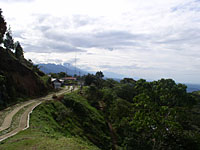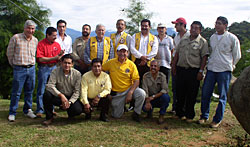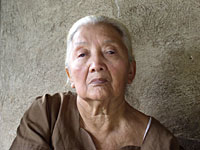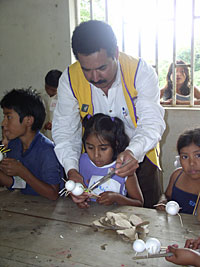By Becky Brookshire, associate director of development, Carter Center Health Programs
The Carter Center is the sponsoring agency for the regional coalition OEPA (Onchocerciasis Elimination Program for the Americas). The coalition works to eradicate onchocerciasis - also known as river blindness - in the Americas through semi-annual distribution of the safe and effective oral microfilaricide ivermecin (Mectizan®), donated by Merck & Co, Inc. The OEPA partnership includes the governments of endemic countries, Lions Clubs, the Pan American Health Organization, and the United States Centers for Disease Control and Prevention. Support is provided by donors such as the Bill & Melinda Gates Foundation, Lions Clubs International Foundation, Merck & Co, Inc, and many others.
Late in the afternoon on a hot, humid August day under skies that threaten rain, I find myself climbing upward on a steep path through the woods near the small community of Brasil, Mexico. Barely three months after being hired by The Carter Center, I am swept up in the excitement of my first work trip into the field, where villagers who are at risk for river blindness will receive the preventative treatment, Mectizan®. My spirit is soaring to be here, but I fight exhaustion as we struggle through the heat. One of my companions is Dr. Francisco Cabrera, a 72-year-old doctor who has been an energetic member of the Lions Club in Mexico City for 58 years. Amazingly, he is making this climb look easy.
We are on a two-day visit to the small, rural communities of Brasil and Estrella Roja in the southernmost part of the state of Chiapas. Our group includes doctors, scientists, and public health workers from OEPA, the Programa de Oncocercosis de la Secretaría de Salud (Mexican Ministry of Health Onchocerciasis Program), the Mexican National Center for Epidemiological Surveillance, local Lions Clubs, and a film crew associated with the Lions Clubs International Foundation. Together we have traveled on rugged dirt trails into the mountains through forests dense with tropical plants, vines, and wildlife to some of the poorest parts of Mexico.
Our hike today is to the home of Pitasia González, a 78-year-old blind woman, who lives with her daughters Marquina and Manuela. The house is a simple, one-room hut with dirt floors and a wood fire pit for cooking. Because her home is located deep in the fields outside Brasil, the only access is by foot through the surrounding hillside which her daughters must climb for any household needs. As I navigate the difficult path, I realize how isolated the family is from such necessities as immediate medical attention.
Like many of the women in the nearby communities, Ms. González was once a strong and capable provider for her family. However, due to the damage caused years ago by onchocerciasis, she has lost her sight. She explains that her blindness has made her dependant on her daughters, unable to care for herself or navigate their small property without help.
"My daughters must cook my meals, clean the house, and help me dress," she said. As she tells us this story, she cries into her hands. She expresses hope, however, when she explains that her grandchildren receive treatment through the OEPA program each year, and that she is thankful their generation has the opportunity to preserve their vision.
"I'm glad my grandchildren take the Mectizan," she said.
Ms. González is one of a very few blind residents of Brasil, a sign of the success of the Mexican program. In the communities, most people are protected by the Mectizan treatments and health education provided by OEPA. However, even during our visit, some of the children are discovered to have skin nodules that indicate infection by the parasite. If those children continue to receive treatment, these symptoms will not advance. Mexico has reached its greater than 85 percent treatment goal for the past four years. The country's last push to eliminate onchocerciasis happens here in the state of Chiapas, where 15,522 of the total 16,004 reported cases in Mexico occur.
Later that day, in a small schoolhouse, public health workers set up their Mectizan® distribution center where local residents will receive their tablets twice each year. As a way to learn about the black flies that transmit the disease, the children have made little toy black flies out of styrofoam and paint, and they joyfully fly their bugs on small wooden sticks throughout the classroom. As I watch public health workers teach the children and help them paint their bugs, I see a dedication and affection that is clearly the reason Mexico has had such success.
One of the most striking aspects of my experience here is the kindness, comradery, and respect between the health workers and the people being helped. Many in the group are doctors and scientists: brilliant men who are still able to bring warmth and openness to little children painting styrofoam flies, elderly women who have lost their sight, farm hands and workers striken with poverty. I am amazed by the personal devotion of the health workers, and by the strength and resourcefulness of the people in the village who are at risk for the disease.
Endemic countries in Latin America have been fighting onchocerciasis for more than 500 years. It is believed the disease was first carried to the Americas from Africa through the slave trade, and over time it has spread throughout vulnerable regions. A great deal of dedication has been contributed to the effort to eliminate onchocerciasis. It has taken the commitment of hundreds of people who came before to get this far. It has taken the endurance of the health workers who sleep on concrete floors to ensure people in remote areas have access to medicine and public education, dedicated Lions Club members like Dr. Cabrera who aim to preserve sight, generous donors across the globe who have supported the elimination of a distant and debilitating disease, and the perseverance of the villagers themselves. For many years, they have conscientiously lined up for preventative treatment and taught their children to do the same. These people have seen the devastating effects of onchocerciasis in people like Ms. Gonzales and are fighting back, so that their children and grandchildren can keep their vision.
The Carter Center works to eradicate river blindness in six endemic countries in the Americas (Brazil, Columbia, Ecuador, Guatemala, Mexico, and Venezuela) and to control it in five endemic countries in Africa (Cameroon, Ethiopia, Nigeria, Sudan, and Uganda). In 2004, The Carter Center and its partners celebrated its 60 millionth assisted treatment with Mectizan, and the first year in which the program assisted in treating more than 10 million people. There are over 100 million persons at risk for river blindness worldwide.

PHOTOS: BECKY BROOKSHIRE
View of the road to Brasil, Mexico.

The public health team on the trip to Brasil.

Pitasia González, age 78, a Brasil resident blinded by onchocerciasis.

A Lions Club volunteer helps a child paint her "black fly."
Please sign up below for important news about the work of The Carter Center and special event invitations.